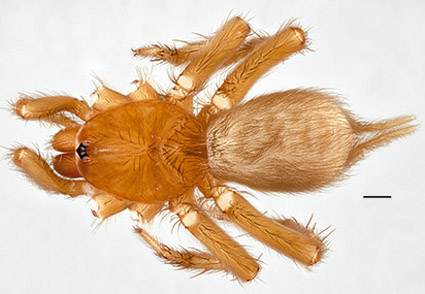Abstract
Dipluridae represent a small Mygalomorphae family of South American origin, the family includes two subfamilies Diplurinae and Masteriinae although the placement of the latter in Dipluridae is still under debate. The family has a predominantly South American distribution although the genus Masteria L. Koch, 1873 presents an interesting distribution with representatives found in Fiji, Micronesia, New Caledonia, New Guinea and Australia. This genus is diverse at the species level in tropical South America and the Caribbean but no species have been described from Ecuador to date. Ongoing field work as part of the BIO-GEEC Project—a consortium established by several Ecuadorian and German institutions—has resulted in the discovery of several new species from both lowlands and highland habitats in Ecuador. Herein we described seven new species of Masteria from Ecuador: M. jatunsacha n. sp. (male); M. machay n. sp. (female); M. chalupas n. sp. (male); M. papallacta n. sp. (male and female); M. pasochoa n. sp. (male and female); M. lasdamas n. sp. (male); and M. otongachi n. sp. (male). The type species of the genus, Masteria hirsuta L. Koch, 1873 from Fiji, is redescribed and re-illustrated, from the original type specimen.
References
Aguirre, Z., Toasa, G. & Gálvez, J. (2013) Región Andes. In: Galeas, R., Guevara, J.E., Medina-Torres, B., Chinchero, M.A. & Herrera, X. (Eds.), Sistema de Clasificación de Ecosistemas del Ecuador Continental. Ministerio del Ambiente del Ecuador, Quito, pp. 88–90.
Álvarez-Padilla, F. & Hormiga, G. (2007) A protocol for digesting internal soft tissues and mounting spiders for scanning electron microscopy. Journal of Arachnology, 35, 538–542. https://doi.org/10.1636/Sh06-55.1
Guevara, J. & Morales, C. (2013) Región Andes. In: Galeas, R., Guevara, J.E., Medina-Torres, B., Chinchero, M.A. & Herrera, X. (Eds.), Sistema de Clasificación de Ecosistemas del Ecuador Continental. Ministerio del Ambiente del Ecuador, Quito, pp. 83–84.
Guevara, J., Mogollón, H., Céron, C. & Josse, C. (2013a) Región Andes. In: Galeas, R., Guevara, J.E., Medina-Torres, B., Chinchero, M.A. & Herrera, X. (Eds.), Sistema de Clasificación de Ecosistemas del Ecuador Continental. Ministerio del Ambiente del Ecuador, Quito, pp. 108–110.
Guevara, J., Pitmann, N., Mogollón, H., Céron, C. & Palacios, W. (2013b) Región Andes. In: Galeas, R., Guevara, J.E., Medina-Torres, B., Chinchero, M.A. & Herrera, X. (Eds.), Sistema de Clasificación de Ecosistemas del Ecuador Continental. Ministerio del Ambiente del Ecuador, Quito, pp. 178–180.
Josse, C. & Aguirre, Z. (2013) Región Andes. In: Galeas, R., Guevara, J.E., Medina-Torres, B., Chinchero, M.A. & Herrera, X. (Eds.), Sistema de Clasificación de Ecosistemas del Ecuador Continental. Ministerio del Ambiente del Ecuador, Quito, pp. 76–77.
Koch, L. (1873) In: Die Arachniden Australiens, nach der Natur beschrieben und abgebildet Bauer & Raspe, Nürnberg, pp. 369–472, pls. 28–36. https://doi.org/10.5962/bhl.title.121660
Mutke, J. & Barthlott, W. (2005) Patterns of vascular plant diversity at continental to global scales. Biologiske Skrifter, 55, 521–531.
Myers, N., Mittermeier, R.A., Mittermeier, C.G., da Fonseca, G.A.B. & Kent, J. (2000) Biodiversity hotspots for conservation priorities. Nature, 403, 853–858. https://doi.org/10.1038/35002501
Opatova, V., Hamilton, C.A., Hedin, M., Montes de Oca, L., Král, J. & Bond, J.E. (2020) Phylogenetic systematics and evolution of the spider infraorder Mygalomorphae using genomic scale data. Systematic Biology, 69 (4), 671–707. https://doi.org/10.1093/sysbio/syz064
Passanha, V. & Brescovit, A.D. (2018) On the Neotropical spider subfamily Masteriinae (Araneae, Dipluridae). Zootaxa, 4463 (1), 1–73. https://doi.org/10.11646/zootaxa.4463.1.1
Raven, R.J. (1979) Systematics of the mygalomorph spider genus Masteria (Masteriinae: Dipluridae: Arachnida). Australian Journal of Zoology, 27 (4), 623–636. https://doi.org/10.1071/ZO9790623
Raven, R.J. (1991) A revision of the mygalomorph spider family Dipluridae in New Caledonia (Araneae). In Chazeau, J. & Tillier, S. (Eds.), Zoologia Neocaledonica, Vol. 2. Mémoires du Muséum National d’Histoire Naturelle de Paris, (A), 149, pp. 87–117.
Raven, R.J., Jell, P.A. & Knezour, R.A. (2015) Edwa maryae gen. et sp. nov. in the Norian Blackstone Formation of the Ipswich Basin- the first Triassic spider (Mygalomorphae) from Australia. Alcheringa: An Australasian Journal of Palaeontology, 39 (2), 259–263. https://doi.org/10.1080/03115518.2015.993300
Roewer, C.F. (1963a) Araneina: Orthognatha, Labidognatha. Insects of Micronesia, 3 (4), 105–132.
Salgado, S., Cuesta, F., Báez, S., Josse, C. & Menina-Torres, B. (2013) Región Andes. In: Galeas, R., Guevara, J.E., Medina-Torres, B., Chinchero, M.A. & Herrera, X. (Eds.), Sistema de Clasificación de Ecosistemas del Ecuador Continental. Ministerio del Ambiente del Ecuador, Quito, pp. 134–135.
Simon, E. (1892a) Histoire naturelle des araignées. Deuxième édition, tome premier. Roret, Paris, 256 pp. https://doi.org/10.5962/bhl.title.51973
Simon, E. (1892c) Arachnides. In: Raffrey, A., Bolivar, I. & Simon, E., Études cavernicoles de l’île Luzon. Voyage de M. E. Simon aux l’îles Phillipines. 4e Mémoire. Annales de la Société Entomologique de France, 61, pp. 35–52.
Valencia, R. & P.M. Jørgensen (2008) Composition and Structure of a Humid Montane Forest on the Pasochoa Volcano, Ecuador. Nordic Journal of Botany, 12 (2), 239–247. https://doi.org/10.1111/j.1756-1051.1992.tb01301.x
World Spider Catalog (2021) World Spider Catalog. Version 22.0. Natural History Museum Bern, Bern. Available from: http//wsc.nmbe.ch (accessed 2 January 2021)


